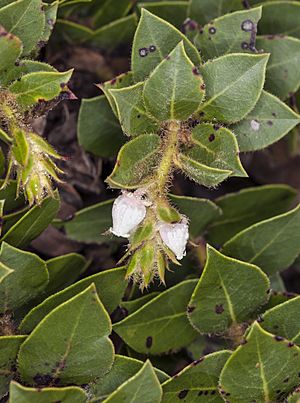San Bruno Mountain manzanita facts for kids
Quick facts for kids San Bruno Mountain manzanita |
|
|---|---|
 |
|
| Scientific classification | |
| Kingdom: | |
| (unranked): | |
| (unranked): | |
| (unranked): | |
| Order: | |
| Family: | |
| Genus: | |
| Species: |
A. imbricata
|
| Binomial name | |
| Arctostaphylos imbricata |
|
Arctostaphylos imbricata is a special kind of plant called a manzanita. Its common name is the San Bruno Mountain manzanita. This plant is quite rare! It only grows in one specific place: San Mateo County, California. You can find it on San Bruno Mountain.
Contents
About the San Bruno Mountain Manzanita
This manzanita is very unique because it's endemic to this small area. This means it naturally grows nowhere else in the world! It is only found in six small groups on San Bruno Mountain.
Protecting This Rare Plant
Even though it's rare, this manzanita is not officially listed as an endangered species by the government. This is because most of its groups are protected. They are safe thanks to a special plan called the San Bruno Mountain Habitat Conservation Plan. This plan helps keep their home safe.
Where It Lives and How It Grows
The San Bruno Mountain manzanita lives in a type of plant community called chaparral. Chaparral areas are often dry and have many shrubs. Like many other plants in chaparral, this manzanita needs wildfire to help it reproduce. Fire helps its seeds sprout and new plants grow. If fires are stopped in its natural home, it can be a danger to its survival.
What the San Bruno Mountain Manzanita Looks Like
The Arctostaphylos imbricata is a small plant. It grows as a low, spreading shrub. It often forms flat tangled mats or small mounds. These mounds are usually less than a meter (about 3 feet) tall.
Branches and Leaves
Its branches are covered in long, stiff hairs called bristles. These bristles have sticky resin glands on their tips. The leaves are a light green color. They are round or oval shaped. They feel rough and bristly, and their surfaces are dull. The edges of the leaves can be smooth or have small teeth. Each leaf can grow up to 4 centimeters (about 1.5 inches) long and 3 centimeters (about 1 inch) wide.
Flowers and Fruit
The plant produces many flowers in a dense cluster. Each flower is small, only 3 to 5 millimeters long. They are white and shaped like a rounded urn. After the flowers, the plant grows a fruit. This fruit is called a drupe. It is hairy and glandular, just like the branches. The fruit is about 7 millimeters (about 0.25 inches) wide.

